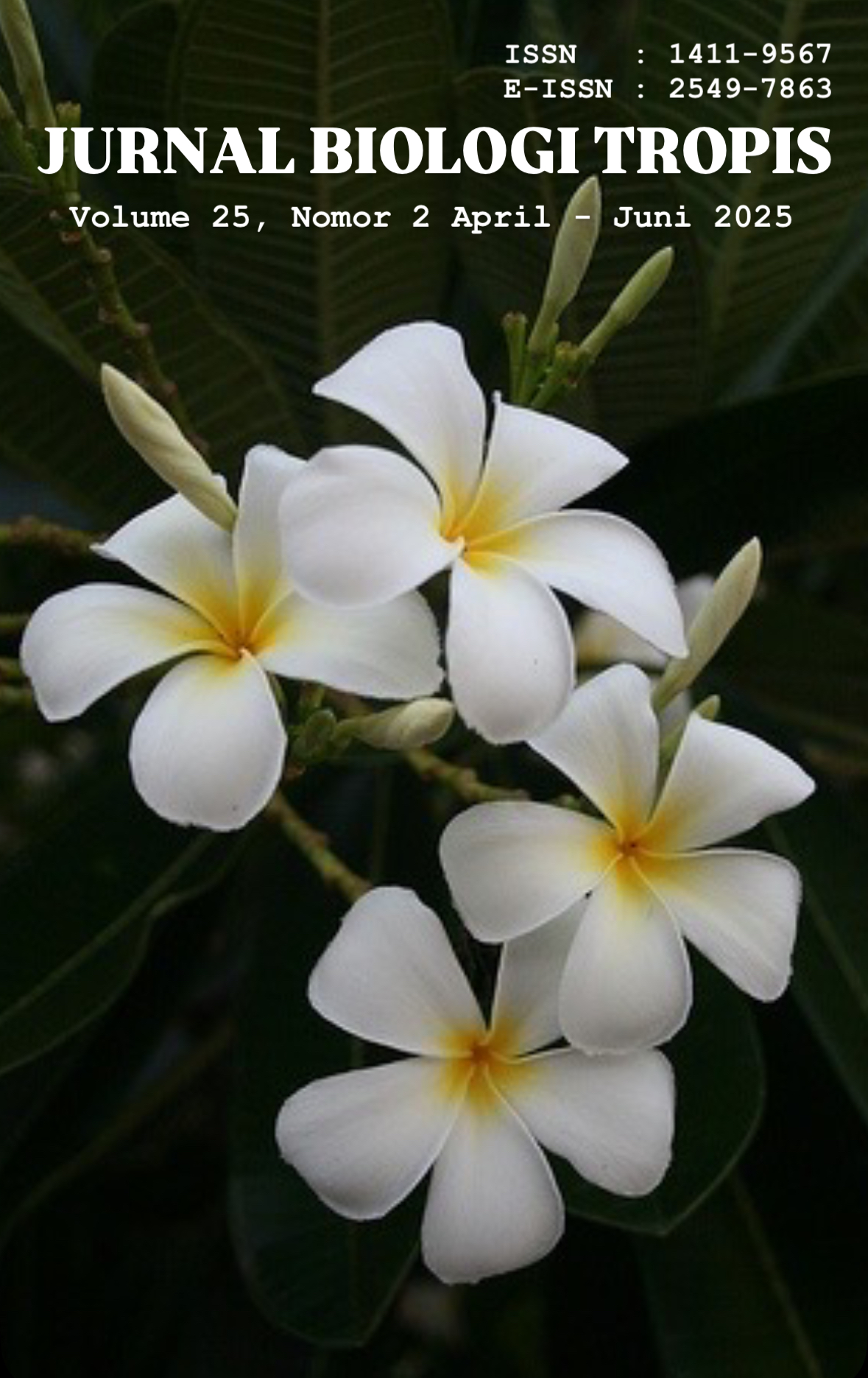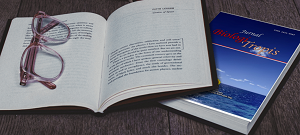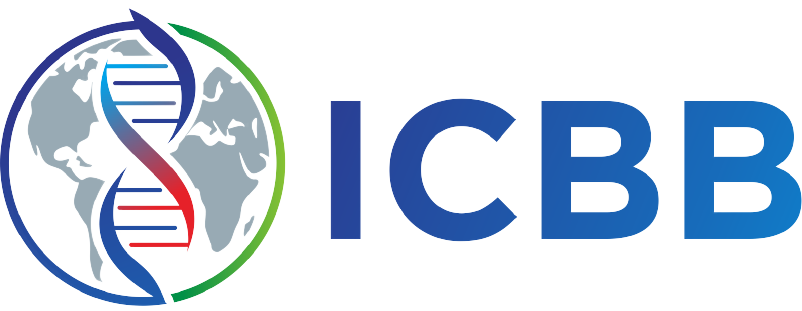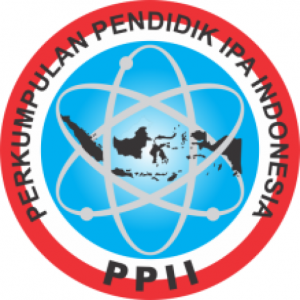Effect Differences Depth on Chlorophyll Content (Kappaphycus alvarezii) Seaweed Tissue Culture Cultivated in The Waters of Gerupuk Bay
Authors
Iin Safitri , Salnida Yuniarti Lumbessy , Nunik CokrowatiDOI:
10.29303/jbt.v25i2.9085Published:
2025-05-21Issue:
Vol. 25 No. 2 (2025): April-JuniKeywords:
Chlorophyll, depth, seaweed, tissue culture.Articles
Downloads
How to Cite
Downloads
Metrics
Abstract
Seaweed developed through tissue culture techniques has several advantages, such as high carrageenan content, rapid growth, and resistance to disease. In seaweed cultivation, growth is influenced by photosynthetic pigments such as chlorophyll. Chlorophyll plays an important role in converting sunlight into chemical energy needed for growth. This study aims to analyze the chlorophyll content in Kappaphycus alvarezii cultivated at different depths in Gerupuk Bay waters. This study used an experimental method with a completely randomized design (CRD) consisting of 4 treatments and 3 replications, namely depths of 0 cm (P1), 5 cm (P2), 10 cm (P3), and 15 cm (P4). Results of this study indicate that planting at different depths can increase the absolute weight of K. alvarezii tissue culture ranging from 283 g to 356 g, specific growth rate between 5.72%/day to 5.91%/day, seaweed production ranging from 661 g/m2 to 832 g/m2, chlorophyll content between 5.60 mg/L to 21.89 mg/L, and phycoerythrin content between 0.027 mg/L to 0.19 mg/L. The conclusion is that the cultivation of K. alvarezii tissue culture with floating rafts at different depths can affect growth and yield. Cultivation of K. alvarezii seaweed at a depth of 0 cm using the floating raft method gave the best results, namely increasing absolute weight up to 356 g, specific growth rate up to 5.91%/day, and production up to 832 g/m2, supported by chlorophyll content of 21.89 mg/L and phycoerythrin content of 0.195 mg/L. For optimal production results, it is recommended to use a depth of 0 cm in floating raft seaweed cultivation.
References
Afandi, A., & Syam, A. (2020). Analisis Kuantitas Tiga Varietas Rumput Laut Kappaphycus alvarezii yang Dibudidaya Dengan Metode Long Line. Jurnal Akuakultura, 2(2). https://doi.org/10.35308/ja.v2i2.1592
Andiska, A., Irawan, H., & Wulandari, R. (2022). Pengaruh Kedalaman Terhadap Pertumbuhan Rumput Laut Kappaphycus alvarezii Menggunakan Metode Longline. Intek Akuakultur, 5(2), 25–35.
Calari, R. P., Diniarti, N., & Scabra, A. R. (2019). Pengaruh Perbedaan Kedalaman terhadap Kandungan Klorofil dan Rendemen Karaginan Kappaphycus alvarezii. Journal of Marine Research, 1(x), 1–9.
Cokrowati, N., Apriliyanti, F., Nuryatin, N., Jayusri, J., Junaidi, M., & Asri, Y. (2024). Seaweed and its antioxidant content at Batu Layar beach, Senggigi, West Lombok Regency. Depik, 13(3), 494-507. 10.13170/depik.13.3.40014
Cokrowati, N., Yatin, N., Affandi, RI, Susanto, M., & Yanti, SD (2024). Keanekaragaman Rumput Laut di Teluk Ekas, Kabupaten Lombok Timur, Nusa Tenggara Barat. Jurnal Biologi Tropis , 24 (1), 714-721. http://dx.doi.org/10.29303/jbt.v24i1.6702
Cokrowati, N., Diniarti, N., Setyowati, D. N., & Mukhlis, A. (2020). Pertumbuhan Rumput Laut dan Rumput Laut Lokal Hasil Kultur Jaringan Kappaphycus alvarezii. Jurnal Biologi Tropis, 4(1), 61–65.
Cokrowati, N., Diniarti, N., Setyowati, D. N., Waspodo, S., & Marzuki, M. (2019). Ekplorasi dan Penangkaran Bibit Rumput Laut (Eucheuma cottonii) di Perairan Teluk Ekas Lombok Timur. Jurnal Biologi Tropis, 19(1), 51–53. https://doi.org/10.29303/jbt.v19i1.994
Cokrowati, N., Jum, M., & Muahidah, N. (2024). Kinerja Pertumbuhan Kappaphycus alvarezii dan Kappaphycus striatus yang dibudidayakan di Teluk Ekas, Kabupaten Lombok Timur , Nusa Bara Provinsi Tenggara. 13(September), 427–439. 10.20473/jafh.v13i3.57374
Cokrowati, N., Risjani, Y., Andayani, S., & Firdaus, M. (2023). The Potential and Development of Seaweed Cultivation in Lombok: A Review. Jurnal Biologi Tropis, 23(1), 202–212. https://doi.org/10.29303/jbt.v23i1.4654
Fatonny, N., Nurmalina, R., & Fariyanti, A. (2023). Analisis Sistem Agribisnis Rumput Laut di Kabupaten Takalar Provinsi Sulawesi Selatan. Forum Agribisnis, 13(1), 35–49. https://doi.org/10.29244/fagb.13.1.35-49
Febriani, A., Diniarti, N., & Setyono, B. D. H. (2022). Pengaruh Kedalaman Berbeda Terhadap Kandungan Klorofil-a dan Karotenoid Rumput Laut Kappaphycus alvarezii di Perairan Teluk Ekas, Lombok Timur. Jurnal Perikanan Unram, 12(4), 493–503. https://doi.org/10.29303/jp.v12i4.329
Freitas, M. V., Pacheco, D., Cotas, J., Mouga, T., Afonso, C., & Pereira, L. (2022). Red Seaweed Pigments from a Biotechnological Perspective. Phycology, 2(1), 1–29. https://doi.org/10.3390/phycology2010001
Hulpa, W. L., Cokrowati, N., & Diniarti, N. (2021). Pertumbuhan Rumput Laut Sargassum Sp. yang Dibudidaya Pada Kedalaman Berbeda Di Teluk Ekas Lombok Timur. Jurnal Kelautan: Indonesian Journal of Marine Science and Technology, 14(2), 185–191. https://doi.org/10.21107/jk.v14i2.10934
KKP. (2022). Rilis Data Kelautan dan Perikanan Triwulan IV Tahun 2022. Pusat Data, Statistik, dan Informasi Sekretariat Jendral Kementrian Kelautan dan Perikanan.
Kurnianingsih, R., Ghazali, M., Rosidah, S., Muspiah, A., Astuti, S. ., & Nikmatullah, A. (2020). Pelatihan Teknik Dasar Kultur Jaringan Tumbuhan. JMM (Jurnal Masyarakat Mandiri), 4(5), 888–896. https://doi.org/10.31764/jmm.v4i5.3049
Lestari, N. A., Lumbessy, S. Y., & Scabra, A. R. (2023). Perbandingan Pertumbuhan dan Kandungan Pigmen Rumput Laut Eucheuma Cottonii Lokal dan Hasil Kultur Jaringan. JFMR-Journal of Fisheries and Marine Research, 7(1). https://doi.org/10.21776/ub.jfmr.2023.007.01.6
Lutfiati, L., Cokrowati, N., & Azhar, F. (2022). Difference Long Irradiation on The Growth Rate of Kappaphycus alvarezii. Jurnal Biologi Tropis, 22(1), 121–130. https://doi.org/10.29303/jbt.v22i1.3292
Minsas, S., Nanda, A. R., Nurdiansyah, S. I., Idiawati, N., & Siregar, S. (2023). Kandungan Klorofil-a dan Karotenoid Pada Eucheuma cottoni yang Dibudidayakan Kedalaman Berbeda di Teluk Cina Pulau Lemukutan. Jurnal Kelautan Tropis, 26(2), 369–376. https://doi.org/10.14710/jkt.v26i2.15950
Muhaemin, M., Mayaguezz, H., Kusuma, AH, & Eka Putri, WA (2022). Analisis Profil Fotokimia dan Biomassa Endosimbion Karang Symbiodinium sp. Jurnal Ilmu Perikanan dan Sumberdaya Perairan , 11 (1). https://core.ac.uk/download/pdf/544018673.pdf
Raihanun, B., Junadi, M., & Cokrowati, N. (2022). Pengaruh Kedalaman pada Budidaya Rumput Laut Kappaphycus alvarezii yang Ditanam dengan Sistem Kantong. Jurnal Airaha, 11(02).
SNI [Standar Nasional Indonesia]. 2010. Produksi Rumput Laut Kotoni (Eucheuma cottonii) – Bagian 2: Metode Longline, BSNI 7572.2.2010.
Soares, GM, Oedjoe, MDR, & Turupadang, W. (2024). Pengaruh Kedalaman yang Berbeda terhadap Pertumbuhan dan Kandungan Karaginan Rumput Laut Kappaphycus alvarezii. Jurnal Akuatik , 7 (2). https://ejurnal.undana.ac.id/index.php/jaqu/article/view/18700
Sunarpi, S., Prasedya, E. S., Jupri, A., Sunarwidhi, A. L., Hernawan, A., Ilhami, B. T. K., Abidin, A. S., & Widyastuti, S. (2020). Diseminasi Perbandingan Produksi Rumput Laut Menggunakan Teknologi Metode Rakit dan Long line di Teluk Ekas Lombok Timur. Jurnal Pengabdian Magister Pendidikan IPA, 3(2). https://doi.org/10.29303/jpmpi.v3i2.486
Supiandi, M., Cokrowati, N., & Rahman, I. (2020). Pengaruh Perbedaan Jarak Tanam Terhadap Pertumbuhan Rumput Laut (Eucheuma cottonii) Hasil Kultur Jaringan dengan Metode Patok Dasar Di Perairan Gerupuk. Jurnal Perikanan Unram , 10 (2), 158-166. https://doi.org/10.29303/jp.v10i2.206
Yatin, N., Cokrowati, N., & Azhar, F. (2023). Penggunaan Pupuk NPK untuk Budidaya Rumput Laut Eucheuma spinosum dengan Dosis Berbeda dalam Skala Laboratorium. Jurnal Biologi Tropis, 23 (1), 121-130. http://dx.doi.org/10.29303/jbt.v23i1.5977122
Zainuddin, F., & Nofianti, T. (2022). Pengaruh Nutrient N Dan P Terhadap Pertumbuhan Rumput Laut Pada Budidaya Sistem Tertutup. Jurnal Perikanan Unram, 12(1), 116–124. https://doi.org/10.29303/jp.v12i1.279
Zakariah, M. I., Koto, S., Irsan, & Fesanrey, W. (2023). Analisis Kualitas Perairan Budidaya Rumput Laut di Dusun Saliong Desa Batu Boy Sebagai Dampak Gagal Panen. Jurnal Biologi Pendidikan Dan Terapan, 10(1), 91–101. https://ojs3.unpatti.ac.id/index.php/biopendix/article/download/10448/6451
Zega, N. D., Mendrofa, E. G., Gea, C. J., Halawa, L. S. W., Lase, H. S., Waruwu, I., & Lase, N. K. (2024). Perbandingan Laju Fotosintesis Pada Tanaman yang Tumbuh Di Tempat Terang Dan Gelap. Jurnal Ilmu Pertanian dan Perikanan, 1(2), 162-169. https://sihojurnal.com/index.php/penarik/article/view/225
License
Copyright (c) 2025 Iin Safitri, Salnida Yuniarti Lumbessy, Nunik Cokrowati

This work is licensed under a Creative Commons Attribution 4.0 International License.

Jurnal Biologi Tropis is licensed under a Creative Commons Attribution 4.0 International License.
The copyright of the received article shall be assigned to the author as the owner of the paper. The intended copyright includes the right to publish the article in various forms (including reprints). The journal maintains the publishing rights to the published articles.
Authors are permitted to disseminate published articles by sharing the link/DOI of the article at the journal. Authors are allowed to use their articles for any legal purposes deemed necessary without written permission from the journal with an acknowledgment of initial publication to this journal.


























